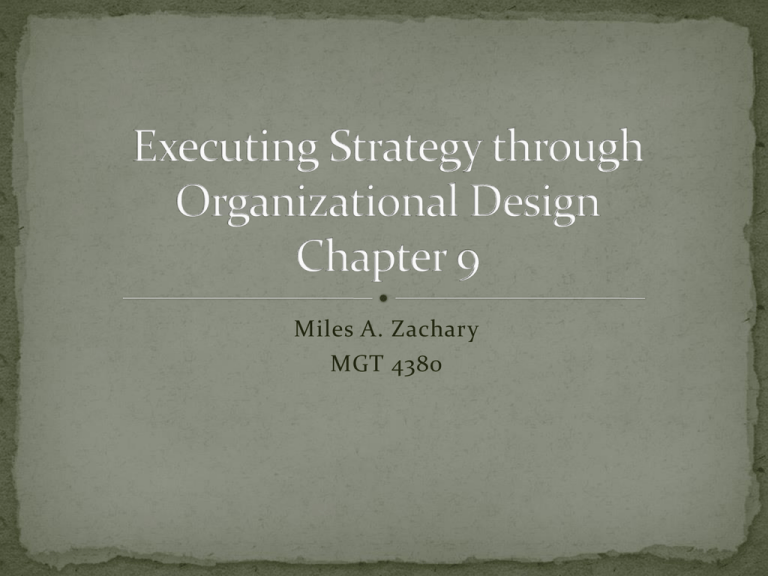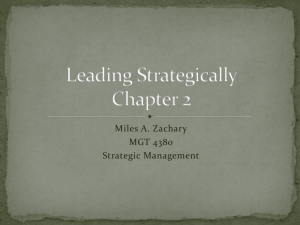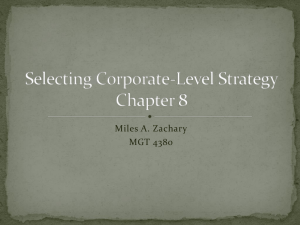Week 13
advertisement

Miles A. Zachary MGT 4380 Executives able to skillfully orchestrate structure and control are likely to lead their firms to greater levels of success Development of a strong structure and control system begins with the building blocks of organizational structure Division of labor Organizational chart Vertical and Horizontal linkages Informal linkages Unity of command principle Division of labor is the process by which a task is split into a series of smaller tasks, each performed by a specialist The oldest record of management practices parables the importance of the division of labor Jethro teaches Moses to establish a hierarchy of authority to better manage the freed Hebrews A hierarchy of authority is an arrangement of individuals based on rank (e.g., the military) Greek philosopher and contemporary of Socrates, Xenophon, noted the increased efficiency of shoemakers who divide the task of making shoes Later scholars such as Duhamel du Monceau (1761) and Smith (1776) write about the benefits of the division of labor more explicitly Others were much more critical of the division of labor Karl Marx (1844) suggested that it alienates works who become “depressed spiritually and physically to the condition of a machine” Henry David Thoreau (1854) believes that it removes a workers sense of connectedness with society Adam Smith (1776), while championing its efficiency, does discuss how it can be monotonous and lead to depressing work environments While division of labor can create efficiencies, determining how to coordinate the tasks and people who perform them is challenging The solution is organizational structure—how tasks are assigned and grouped together with formal reporting relationships Adequate structure increases a firm’s likelihood of success A firm’s structure is often a function of environmental fit For example, Burns & Stalker (1961) suggested that in static environments, a firm can gain efficiencies from having a rigid hierarchy; however, in dynamic environments, a firm benefits from greater flexibility Many firms use organizational charts to diagram their structure: show the various vertical and horizontal linkages A vertical linkage tie supervisors to subordinates and show the lines through which supervisors delegate authority, oversee activities, evaluate performance, and administer feedback When mapping vertical linkages in an organizational structure, most executives rely on the unity of command principle Each employee should report to only one supervisor; multiple bosses can be confusing A horizontal linkage is a relationship between equals in an organizations; sometimes called committees, teams, task forces, etc. depending on the extent of the relationship Important when close coordination is needed across the organization Informal linkages do not appear in the formal organizational chart and refer to an unofficial relationship between employees based on personal friendships, rivalries, and politics The vertical and horizontal linkages among employees forms the foundation of organizational structure Executives may use a variety of combinations of vertical and horizontal linkages to design an effective structure Four (4) common types of structure Simple Functional Multidivisional Matrix Executives must weight the benefits and costs of different structures because, once formed, structure can either aid or constrain strategy Early strategy scholars (e.g., Chandler, 1962; Pierce, 1974) conceptualized the S-C-P model Structure Conduct (Strategy) Performance In a simple organizational structure, an organizational chart is usually not needed Most firms begin with a simple structure When a firm is owned and operated by a single individual or a small group of people In organizations composed of more than a single person, tasks are usually assigned informally rather than formally; strategic decisions are highly centralized (owner) The flexibility of a simple structure encourages creativity and individualism and high responsiveness Without a formal structure, informally-assigned duties may not be accomplished; lack of clear guidance; confusing when more employees are hired As a small organization grows, simple structure begins to become ineffective thanks to added complexity Complexities need to be managed by formalized structures with emphasis on hierarch and vertical links A functional structure divides employees into departments that handle activities related to a functional area of the business (e.g., marketing, production, customer service, human resources, etc.) Each area is often headed up by a manager with all employees reporting to their respective manager An important benefit of the functional structure is that each person tends to learn much about their particular function (specialization) Tends to create highly skilled specialists Grouping functional areas decreases costs by creating efficiencies and employees with similar training backgrounds tend to get along better on average Increased hierarchical levels can be slow to disseminate information and execute changes Functional structures are often useful in situations where a firm has limited products or services (e.g., single offerings) When a firm begins to offer more than a few products or services (often across a wide geographical area), they often require a more responsive organizational structure Naturally, firms often move from a functional form to a multidivisional structure in which employees are divided into departments based on product areas and/or geographic regions One of the big advantages of the multidivisional form is that it allows firms to act quickly This can backfire when divisions are loosely-coupled and are generally unaware and/or unmotivated to align with the firms overarching strategy Also, since multidivisional structures are basically coupled functional structures, they do not benefit from the efficiency of single departments across the entire company Instead, they need individual departments within each division While functional and multidivisional structures rely primarily on vertical linkages, matrix structures rely more on horizontal linkages Creates cross-functional teams that work on different projects Advantages include maximizing organizational flexibilities, enhancing communication across functional lines, and creating a spirit of teamwork and collaboration Violates the unity of command principle potentially creating confusion and/or conflict between managers Good for organizations that need to maximize flexibility such as high technology, engineering, and consulting firms Boundaryless organizations are ones that remove the usual barriers between parts of the organization and between them and other organizations While absolute state is improbable, moving toward that state can help an organization become more flexible and responsive E.g., W. L. Gore No formal titles allows leaders to emerge based on performance, attracting followers to new innovative ideas Structural boundaries can inhibit and constrain firms, but can also provided needed order An organization’s structure is not a static choice, but rather should be revisited as the organization evolves Managers and executives should be cognizant of “danger signs” (e.g., slow response time, poor performance) Finding structural balance is difficult but desirable Effective structure and strategy depends on skillful use of organizational control systems Control systems allow executives to track organizational performance, identify concern areas, and then take action to address concerns Three (3) basic types of control systems Output control Behavioral control Clan control Most firms use a combination of control systems Output control focuses on measurable results within an organization E.g., website hits per day, cars produced per week, sales orders per month, etc. Executives decide what output (performance) level is acceptable, communicate their expectations to employees, track performance, then make changes to either the goals or employees (feedback) as needed Behavioral controls focus on controlling the actions of individuals that ultimately lead to a result E.g., company dress policy, firm purchase procedures, etc. Reflect policies and procedures that are often communicated to employees through a rules and regulations handbook Can be difficult to implement; proper motivation/incentives is key Clan control relies on traditions, expectations, values, and norms to lead individuals to work toward the good of the organization E.g. “the way we do things here…” An informal type of control Based largely on organizational culture While effective, it can be extremely hard to change as culture is inertial Many management fads have come and gone in business including: MBO (management by objectives): goal-setting between supervisor and subordinate to provide structure and motivation Sensitivity training: group discussions leading to greater selfawareness and/or self-actualization Quality circles: employee groups formed to innovate new methods or processes to improve quality Strong culture: interest in Japanese management systems, firms tried to develop strong collectivist cultures While most fads fade away with time, they remind us to be true to our roots; contingency theory is no fad Extremely important decision that determines how organizations structure resources, assets, and liabilities, what strategy a business should use, and how performance can be dispersed and taxed Three (3) basic forms: Sole proprietorship Partnership Corporation Many derivatives exist that have specialized purposes A firm owned by one individual Legally, an individual and their sole proprietorship are one in the same An advantage of this unity is that after taxes are paid, all the profits are theirs to keep or divide at will However, the individual has unlimited liability and any losses in the business transfer to the individual Most sole proprietors are small businesses that try to minimize overhead and other direct costs Two or more individuals enter into a partnership and share ownership of an organization Similar to sole proprietorship in that partners are beneficiaries of profits (and losses) Can be beneficial when partners complement each other However, partnerships often break up and adding or subtracting partners requires rewriting the partnership agreement Many partnerships are professional organizations that combine a group of traditionally independent contractors (e.g., law firms, engineering firms, etc.) Corporations are distinct entities which are viewed as legally separate from their owners (two tax returns— one for the corporation and one for the owner) Separation distinction limits liability of owners Profits and losses are attributed to the firm and must be dispensed by owners (double-taxation) Book error: corporations DO NOT have to issue stock or be professionally-managed, although many are Are the most expensive basic legal form to start, but have considerable benefits for many S-corporations: avoids double-taxation since profits and losses flow directly to the owner(s) tax return; however, limits on # of shareholders (<100) discourage large firms Limited liability company (LLC): granted by state, not federal, laws; owners have limited liabilities, but must choose to be taxed as one of the basic forms; very flexible http://www.inc.com/articles/2000/06/19438.html











